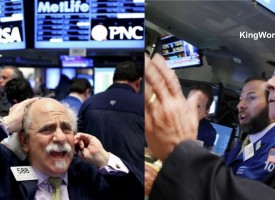As we kickoff the final day of trading in February, one of the top money managers in the world just warned that today’s takedown in the gold market is all smoke and mirrors because China is preparing to stun the world by reintroducing gold into the global monetary system.
But first, after today’s takedown in the gold market, Dr. Stephen Leeb sent this communication…
“Eric, I do believe that that bounce in the dollar probably won’t last and that the yuan will continue to move higher. Over the past 9 months or so gold and the yuan (52-week moving average) have been in line. All in all, I don’t see more than another 2 or 3 percent (decline), say $1270-$1280.”
This is the reason why Dr. Leeb is so confident that after a brief takedown in the gold price, the next major move will be thousands of dollars higher…
Huge Implications For Gold
February 27 (King World News) – Dr. Stephen Leeb: “If all you knew about the future was that the next few decades would be among the most turbulent in history, that would be enough to tell you to start putting a big chunk of your savings into gold. Well, start putting your money into gold. We are indeed facing a prolonged stretch of unusual turbulence, catalyzed by major economic change. Don’t get me wrong. I’m not forecasting anything like a major war, say, or even an economic apocalypse. But I do believe that we will be tested in a big way, and that no event can be ruled out.
In other words, you can’t take anything for granted. Your first order of business under these circumstances is to make sure that come what may, you have a way to obtain the basics – food, basic materials. That means that you want to ensure access to money that will do what money is supposed to do, i.e., be accepted in exchange for the basic goods you need. And that, as may be obvious to some, and as we’ll review below, means gold. But first, more on the coming turbulence…
BONUS INTERVIEW:
To listen to billionaire Eric Sprott discuss his prediction for skyrocketing silver
as well as his top silver pick CLICK HERE OR BELOW:
Dr. Stephen Leeb continues: “I’ve outlined before the major reason the world faces a period of turbulence and transformational change. Namely, for the first time, developing economies are now larger in toto than developed economies. They are driving the future. That has huge implications for demand for resources, which in turn has huge implications for gold.
China’s economy by some measures is the largest in the world. And through various initiatives like the Belt and Road Project, the Shanghai Cooperation Organization, and trade agreements with many of the least developed countries in Africa, China is bringing the developing world together into a collection of economies that, with few exceptions, are all growing at the same time. By definition a developing economy has the potential to grow faster and longer than a developed economy. Until now, however, the developing world has developed in a scattershot manner rather than in any synchronous fashion. China, by virtue of its size and its ambitions to create trading partners throughout the developing world, has changed that. It has reshaped the world into one where the portion with the greatest growth potential is now growing all of a piece.
Also significant is that growth in developing countries differs from growth in developed economies. Developed economies are dominated by the service sector. Developing economies tilt far more towards mining and manufacturing, which entails far greater demand for natural resources. The result is that accelerating growth in the largest portion of the global economy, the developing world, will step up demand for natural resources. This enormous call on resources, the greatest in history, is likely to last for at least for the next two generations.

The $67 Trillion Expense
Indeed, the magnitude of resources today’s developing countries will need over the 22 years – until 2040 – is mind-blowing. During that time, according to the World Bank, infrastructure needs for today’s developing world in today’s dollars will amount to $67 trillion, or more than $3 trillion a year. And let’s not forget that the developed world needs to improve its infrastructure as well. Add in those needs and you’re looking at the potential of more than $4 trillion in infrastructure spending a year.
For some perspective on these numbers, realize that today the world is spending about $2 trillion a year on oil. Obviously, infrastructure creation will require huge amounts of resources other than oil. But since oil is still far and away the most important commodity when it comes to building out infrastructure, it provides a sense of what’s involved. It’s estimated that the build-out in infrastructure will entail some 15 million miles of new roads – enough to circle the globe more than 600 times, according to Science magazine. That will amount to more than 2 million barrels of oil a day just for asphalt, a petroleum product. That equates to more than 2% of current oil demand.
Asphalt, of course, is hardly the only use of oil in road construction. Gasoline and other petroleum fuels are needed to transport that asphalt along with all the other materials used in construction. Estimating the weight of the materials needed in this process, it would require the equivalent of 2.5 million barrels of oil to transport them to the site to build one single mile of road – out of the 15 million miles needed. Roads, which amount to about 35% of forecasted infrastructure needs, are just the start. The remaining 65% includes the infrastructure required for renewable energies, rail transportation, electricity, and more. These, too, will consume massive amounts of existing energy sources, with oil paramount among them.

A New Monetary System Centered Around Gold
China seems to be the only country that truly gets the outsized importance of oil as the world develops in coming years. On March 26, China will start its oft-delayed trading of an Eastern oil benchmark in yuan. It’s a date to watch. I know that many observers are skeptical about whether this benchmark will really have any meaningful impact. To make sure I give full due to all sides, I make a point of spending more time reading what the skeptics have to say than reading the believers. The more I read, the more I believe that this benchmark will be a first step in a new monetary system centered around gold.
One of the best-known and brightest of the skeptics is Ed Morse, head of commodity research at Citigroup. In a February 17 commodity note published in the Financial Times, Morse begins by saying, “U.S. runaway crude oil production…is…positioning the U.S. to be the major oil export hub in the world.” He continues by acknowledging that China is “…aiming to replace the U.S. dollar with the Chinese renminbi as not just the means to pay for oil but to settle general trade. That’s the thrust of Beijing’s ‘Belt and Road’ strategy.” But Morse doesn’t think this will happen because: “…petro-renminbi confronts a major obstacle in replacing the petro-dollar: the U.S. has a dominant and growing role as the hub of global oil and gas trade.”
Petro-Yuan To Replace Petro-Dollar In The East
I think Morse is right on target when it comes to the goal behind establishment of the Eastern oil benchmark – that it’s a step toward replacing the dollar as the world’s reserve currency. But there I part company with him. For one thing, as I’ve said before, I don’t think the Chinese want to replace the dollar with the yuan. Rather they want the new reserve currency to be a basket of currencies anchored in some way to gold.
Moreover, Morse’s argument that “runaway” oil production will thwart Chinese ambitions seems blind to reality. U.S. oil production is and for at least the foreseeable future will continue to be a much smaller percentage of world production than was the case for most of the past two generations. In the grand scheme of things, production gains from fracking haven’t done much to rewrite the U.S. role in world oil production. Throughout the 1970s, for example, the U.S. produced about 30% of the world’s oil supply compared to about 18% today.
This week Continental Petroleum, a major fracker whose production is centered in the Midwest, made even clearer what had been clear already. By lowering its production growth targets, it affirmed that future U.S. growth in oil production must come from the Permian Basin, located in western Texas and New Mexico. The jury is still out on just how prolific for how long the Permian will be. But recent reports from the Basin’s largest landowners, Chevron and Exxon, which have been missing production and profit targets, aren’t exactly heartening.
The bottom line is that even under the best of circumstances the vast majority of oil production and consumption will be centered in the East, where 75% of the world’s oil reserves are located. The most significant new factor isn’t fracking but China. As even Morse implicitly admits, the developing world, much of it centered on the Belt and Road initiative, has coalesced around China.

Turbulent Times Coming But China’s Destiny Is Intertwined With Gold
The odds of a petro-yuan replacing the petro-dollar, at least in East, are somewhere between extremely high and certain. And the only reason I give “extremely high” as a possibility is that you cannot rule out some sort of conflict between East and West. In other words, it is certain the world is headed for a historically turbulent transition led by a country that sees its destiny intertwined with gold. You owe it to yourself and your loved ones to go with the torrent that will be pushing gold to heights hard for most people to imagine today.”
King World News note: Free cash flows for mining companies hit all-time highs in 2016, breaking the record set in 2011, but they are on pace to smash the free cash flow record once again in 2017! And yet the HUI is roughly 72% lower than it was in 2011. That is how irrational things have become in the gold and silver sector, but it will not be a state of permanence. The purpose of the psychological warfare conducted in the paper markets is to keep people away from gold and silver and also to get them to sell.
Games will continue to be played in the paper gold market so that the commercials can cover short positions. But the bottom line is that gold is very close to a historic upside breakout, despite volatility. That is why Western central planners have been fighting like hell to delay this major breakout in gold. No matter how long it takes, time is now on the side of the bulls. As for the bears, time is running out for the orchestrated takedowns…tick-tock, tick-tock.
If you are on a dollar cost average physical gold and silver purchase program, do not get cute and try to time the market. Simply make your purchases at the same time every month or every quarter. For those who are accumulating shares of high-quality mining companies, use bouts of extreme weakness to add to positions and be patient. Time is now firmly on the side of the bulls and against the bears.
ALSO RELEASED: Gold & Oil Hit As New Fed Chair Powell Testifies, But Here Is The Big Question CLICK HERE TO READ.
***Speaking of gold, KWN has just released the extraordinary audio interview with Gerald Celente discussing the action in the gold, silver and major markets as well as what he is planning to do with his own money in the gold market and much more and you can listen to it by CLICKING HERE OR ON THE IMAGE BELOW.
© 2018 by King World News®. All Rights Reserved. This material may not be published, broadcast, rewritten, or redistributed. However, linking directly to the articles is permitted and encouraged.









